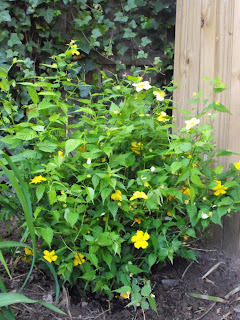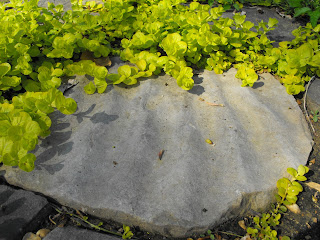If any particular activity or profession might be singled out as excessive for its expectant ways, then I would venture that neither the stock-broker nor the American banker, neither Goldman Sachs executives nor the politician (and no, not even the now-dead, shamed chief executive of Enron, Ken Lay) is as desirous or covetous as the gardener. No, gardeners are most immoderate in their expectations.
If one plants a tomato seed, one expects more than a few tomatoes, correct? If one plants a dahlia tuber, one expects it to make an appearance, not to be eaten by slugs (the tender young shoots of which are the nectar of the slug kingdom), and to produce magnificent flowers by mid-summer. And what if these things do not happen? Well, we get frustrated, we may think dirty thoughts and say dirtier things. We suffer. Buddhism is right after all: whether our sufferings be found in our cravings for a fresh Caprese salad in July or in our ignorance of the dietary needs of the slug. (Perhaps those versions were not translational at all; perhaps casting such a wide net of root causes was intentional...)
 Surely, my dear readers are well aware of my suffering caused by 42 inches of snow as many plants in my front sun garden did not fare well. But my backyard shade garden...well...what a different story! Superabundance! Plant proliferation! Exuberance!
Surely, my dear readers are well aware of my suffering caused by 42 inches of snow as many plants in my front sun garden did not fare well. But my backyard shade garden...well...what a different story! Superabundance! Plant proliferation! Exuberance!So today I write not about failed expectations but about exceeding expectations.
I’ve been apparently under the spell of ignorance, relying on the old gardening adage of “sleep, creep, and leap” which pithily and rhythmically summarizes the first three years of a perennial's life. This year was supposed to be "year of the creep" for many plants, but I’ve done something (wrong?) because my plants have decided to skip the creeping and instead start leaping. And why is this a problem, pray tell?
 Well, my Petasites japonicas (Giant Butterbur) loves deep shade—a shade much deeper than where I planted it. Last year it would wilt each day as the sun hit its preternaturally large leaves; I remained tethered to the hose to help it through, watering Petasites became my quotidian ritual, my homage to botanics and to life itself. I intended on transplanting it to the dense shade of the east garden (protected as it were by the neighbor’s towering hedge). But lo and behold, my 3 ostrich ferns this year have become 9 and thus have conquered territory that would have belonged to Petasites. Also, not to be outdone, Petasites engaged in a bit of subterranean mischief as last year’s 2 plants have become this year’s 7. I am no quantitative methodologist, but I would say that it is a significant multiplier effect!
Well, my Petasites japonicas (Giant Butterbur) loves deep shade—a shade much deeper than where I planted it. Last year it would wilt each day as the sun hit its preternaturally large leaves; I remained tethered to the hose to help it through, watering Petasites became my quotidian ritual, my homage to botanics and to life itself. I intended on transplanting it to the dense shade of the east garden (protected as it were by the neighbor’s towering hedge). But lo and behold, my 3 ostrich ferns this year have become 9 and thus have conquered territory that would have belonged to Petasites. Also, not to be outdone, Petasites engaged in a bit of subterranean mischief as last year’s 2 plants have become this year’s 7. I am no quantitative methodologist, but I would say that it is a significant multiplier effect!  And my new Tassel Fern has suddenly become a neighbor to the Hosta Francee (who comes up with these awful names?!), as the hosta has tripled in volume during the last two or three weeks.
And my new Tassel Fern has suddenly become a neighbor to the Hosta Francee (who comes up with these awful names?!), as the hosta has tripled in volume during the last two or three weeks.I could name numerous other “problems” but I shan’t because it is both immoderate and, really, not at all a problem. My suffering is a labor of love.
True, I could very well remove the ostrich ferns and transplant Petasites, but I have not yet become an intrepid gardener (see an earlier blog post). The Buddhist would say my suffering of love is but a ridiculous Western label to hide my avoidance of the real issue: I am attached to things, and this attachment occludes my judgment. My attachments produce cravings. And my cravings, not love, are the cause of my suffering. (Damn you Buddhist critic, for making a mockery of my logic!)
And so my botanical superabundance and the saturation of my expectations moves me to a precipice I never thought I would experience, or at least would not experience with such trepidation or angst: to kill or not to kill? I haven’t a large property and thus am constrained. The choice must be made.
But now I think I have figured out age-old gardening wisdom and practice—one which I admittedly could not understand as I am, as my Buddhist critic has revealed, a materialist at heart.
To position oneself as arbiter between life and death produces such great discomfort and paralysis that the only thing one can do is to give: to give away that superabundance, to see life transferred, and to experience joy at not having to make such awful decisions.
Who would have imagined that gardening could be such morally trying work.





























